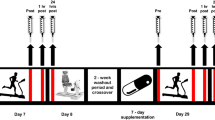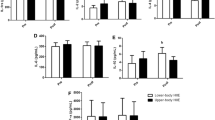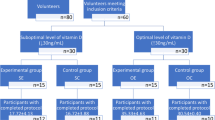Abstract
Purpose
To verify the acute and chronic effects of high-intensity intermittent training (HIIT) on interleukin 15 (IL-15) response and the relationship between circulating IL-15 concentrations and muscle damage in young men.
Methods
Physically active men performed two different training protocols at moderate and high intensity, three times per week for 5 weeks. Twenty subjects were randomly allocated into high-intensity intermittent training group (HIIT-5 km 1 min at 100% of maximal aerobic speed interspersed by 1 min passive recovery; n = 10) or moderate-intensity continuous training group (MICT-5 km 70% of maximal aerobic speed; n = 10). An acute exercise session was performed with blood sample collection pre-exercise, immediately post-exercise, and 60 min post-exercise (before and after 5 weeks of training). Blood samples were used to analyze serum IL-15 and creatine kinase (CK) concentrations.
Results
The results showed no changes in serum IL-15 concentrations independent of protocol, moment measurement, and intervention period. CK concentrations showed higher values post-exercise when compared to pre-exercise in both protocols. No significant relationship was found between serum IL-15 and CK concentrations.
Conclusion
Our findings point to the absence of acute and chronic changes in serum IL-15 concentrations in response to 5 weeks of high-intensity intermittent training. In addition, data suggest that the release of this cytokine is not related to muscle damage in healthy young men.

Similar content being viewed by others
References
Nielsen AR, Pedersen BK (2007) The biological roles of exercise-induced cytokines: IL-6, IL-8, and IL-15. Appl Physiol Nutr Metab 32:833–839. https://doi.org/10.1139/h07-054
O’Leary MF, Wallace GR, Bennett AJ et al (2017) IL-15 promotes human myogenesis and mitigates the detrimental effects of TNFα on myotube development. Sci Rep 7:1–11. https://doi.org/10.1038/s41598-017-13479-w
Nadeau L, Aguer C (2019) Interleukin-15 as a myokine: mechanistic insight into its effect on skeletal muscle metabolism. Appl Physiol Nutr Metab 44:229–238. https://doi.org/10.1139/apnm-2018-0022
Tamura Y, Watanabe K, Kantani T et al (2011) Upregulation of circulating IL-15 by treadmill running in healthy individuals: is IL-15 an endocrine mediator of the beneficial effects of endurance exercise? Endocr J 58:211–215
Rinnov A, Yfanti C, Nielsen S et al (2013) Endurance training enhances skeletal muscle interleukin-15 in human male subjects. Endocrine 45:271–278. https://doi.org/10.1007/s12020-013-9969-z
Cabral-Santos C, Gerosa-Neto J, Inoue DS et al (2015) Similar anti-inflammatory acute responses from moderate-intensity continu-ous and high-intensity intermittent exercise. J Sport Sci Med 14:849–856
Berthoin S, Gerbeaux M, Turpin E et al (1994) Comparison of two field tests to estimate maximum aerobic speed. J Sports Sci 12:355–362. https://doi.org/10.1080/02640419408732181
Lira FS, dos Santos T, Caldeira RS et al (2017) Short-term high- and moderate-intensity training modifies inflammatory and metabolic factors in response to acute exercise. Front Physiol 8:856. https://doi.org/10.3389/fphys.2017.00856
Sardinha M, Teixeira FLS, de Caminha IO et al (2013) Strong correlation of maximal squat strength with sprint performance and vertical jump height in elite soccer players. J Strength Cond Res 15:1. https://doi.org/10.2165/00007256-200838010-00004
Perez-Lopez A, Valades D, Vazquez Martinez C et al (2018) Serum IL-15 and IL-15Ralpha levels are decreased in lean and obese physically active humans. Scand J Med Sci Sports 28:1113–1120. https://doi.org/10.1111/sms.12983
Yang HT, Luo LJ, Chen WJ et al (2014) IL-15 expression increased in response to treadmill running and inhibited endoplasmic reticulum stress in skeletal muscle in rats. Endocrine 48:152–163. https://doi.org/10.1007/s12020-014-0233-y
Hingorjo MR, Zehra S, Saleem S, Qureshi MA (2018) Serum interleukin-15 and its relationship with adiposity indices before and after short-term endurance exercise. Pak J Med Sci 34:1125–1131. https://doi.org/10.12669/pjms.345.15516
Prestes J, Shiguemoto G, Botero JP et al (2009) Effects of resistance training on resistin, leptin, cytokines, and muscle force in elderly post-menopausal women. J Sports Sci 27:1607–1615. https://doi.org/10.1080/02640410903352923
Yeo N, Woo J, Shin K et al (2012) The effects of different exercise intensity on myokine and angiogenesis factors. J Sports Med Phys Fitness 52:448–454
Nielsen AR, Mounier R, Plomgaard P et al (2007) Expression of interleukin-15 in human skeletal muscle effect of exercise and muscle fibre type composition. J Physiol 584:305–312. https://doi.org/10.1113/jphysiol.2007.139618
Nadeau L, Patten DA, Caron A et al (2018) IL-15 improves skeletal muscle oxidative metabolism and glucose uptake in association with increased respiratory chain supercomplex formation and AMPK pathway activation. Biochim Biophys Acta−Gen Subj 1863:395–407. https://doi.org/10.1016/j.bbagen.2018.10.021
Riechman SE, Balasekaran G, Roth SM, Ferrell RE (2004) Association of interleukin-15 protein and interleukin-15 receptor genetic variation with resistance exercise training responses. J Appl Physiol 97:2214–2219. https://doi.org/10.1152/japplphysiol.00491.2004
Molanouri Shamsi M, Hassan ZH, Gharakhanlou R et al (2014) Expression of interleukin-15 and inflammatory cytokines in skeletal muscles of STZ-induced diabetic rats: effect of resistance exercise training. Endocrine 46:60–69. https://doi.org/10.1007/s12020-013-0038-4
Brancaccio P, Lippi G, Maffulli N (2010) Biochemical markers of muscular damage. Clin Chem Lab Med 48:757–767. https://doi.org/10.1515/CCLM.2010.179
Carmona G, Mendiguchía J, Alomar X et al (2018) Time course and association of functional and biochemical markers in severe semitendinosus damage following intensive eccentric leg curls: differences between and within subjects. Front Physiol 9:54. https://doi.org/10.3389/fphys.2018.00054
Brancaccio P, Maffulli N, Limongelli FM (2007) Creatine kinase monitoring in sport medicine. Br Med Bull 81–82:209–230. https://doi.org/10.1093/bmb/ldm014
Ostrowski K, Hermann C, Bangash A et al (1998) A trauma-like elevation of plasma cytokines in humans in response to treadmill running. J Physiol 513:889–894. https://doi.org/10.1111/j.1469-7793.1998.889ba.x
Acknowledgements
Thaislaine dos Santos would like to thank Fundação de Amparo à Pesquisa do Estado de São Paulo (Fapesp) for their support (2016/12145–1). The authors would like to thank Prof. Dr. Valéria Leme Gonçalves Panissa for the statistical analysis.
Author information
Authors and Affiliations
Corresponding authors
Ethics declarations
Conflict of interest
The authors declare no conflict of interest.
Ethical approval
The study was approved by the Research Ethics Committee for studies involving human participants at the State University (Unesp) of the Presidente Prudente School of Technology and Sciences/SP (53297815.8.0000.5402).This study complies with the 1964 Helsinki declaration and its later amendments.
Informed consent
All participants signed a consent form after being informed of the purposes and risks of the study.
Additional information
Publisher's Note
Springer Nature remains neutral with regard to jurisdictional claims in published maps and institutional affiliations.
Rights and permissions
About this article
Cite this article
dos Santos, T., Lira, F. & Antunes, B.M. Interleukin-15 and creatine kinase response to high-intensity intermittent exercise training. Sport Sci Health 16, 479–484 (2020). https://doi.org/10.1007/s11332-020-00629-3
Received:
Accepted:
Published:
Issue Date:
DOI: https://doi.org/10.1007/s11332-020-00629-3




